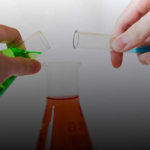Section 1
Preview this deck
Gibbs free energy
Front
Active users
0
All-time users
0
Favorites
0
Last updated
6 years ago
Date created
Mar 1, 2020
Cards (51)
Section 1
(50 cards)
Gibbs free energy
measure of spontaneity of process
∆G°rx
= ∑n∆G(f°products) - ∑n∆G°reactants
particles
in solution have higher entropy values than solids
exothermic reaction
reactants start higher than products
-∆S
becomes more ordered
spontaneous endothermic reaction
∆H > 0 ∆S > 0
2nd Law of Thermodynamics
process spontaneous in one direction can't be spontaneous in reverse direction
entropy
measure of disorder of system
bomb calorimeter sealed, insulated container used for measuring the energy released during combustion
sealed, insulated container used for measuring the energy released during combustion
∆H
H(products)-H(reactants)
standard state conditions
1. all gases are at 1 atm 2. all liquids are pure 3. all solids are pure 4. all solutions are at 1-M 5. the energy of formation of an element in its normal state is defined as 0 6. temperature used for standard state values is almost invariably room temperature. standard state values can be calculated for other temperatures, however.
heat of formation
∆H = ∑H(products)-∑H(reactants)
heating curve
a diagram that shows the temperature changes and changes of state of a substance as it is heated
Enthalpy (heat) of combustion
the heat released or absorbed (enthalpy change) during the formation of a pure substance from its elements, at constant pressure and usually denoted by ΔHf.
heat of vaporization
energy given off when substance condenses
Entropy of a system increases when
gases are formed from solids or liquids, liquids or solutions are formed from solids, the number of gas molecules changes during a chemical reaction
2 moles of substance
have higher entropy value than one mole
what does Q stand for
reaction quotient: the mass action expression at non-equilibrium conditions. the spontaneity of a reaction that has not reached equilibrium has to be measured in terms of ∆G which is not synonomous with ∆G° because the substances are not in standard state
+∆G
the forward process is nonspontaneous (the reverse is spontaneous)
R (in thermo, not gases)
8.31 J/mol*K
∆G
∆G° + RT(lnQ)
+∆S
becomes more random; disordered
endothermic reaction
reactants start lower than products
∆G positive
not spontaneous
spontaneous at all temperatures
-∆H (favorable) +∆H (favorable)
∆G = 0
reaction at equilibrium
heat capacity
heat ÷ ∆T
energy released
bonds formed; exothermic
∆G negative
spontaneous
specific heat
q = mc∆T
addition of catalyst
decreases activation energy only
Exothermic Reactions
negative ∆H, favors spontaneity but does not guarantee it.
spontaneous at high T; non spontaneous at low T
+∆H (unfavorable) +∆S (favorable)
energy absorbed
bonds broken; endothermic
spontaneous at low T; nonspontaneous at high T
-∆H (favorable) -∆S (unfavorable)
Hess's law
The overall enthalpy change in a reaction is equal to the sum of the enthalpy changes of the individual steps of the process.
standard free energy
∆G°(rxn) is the free energy change of a reaction when it occurs under standard conditions; when reactants in their standard states are converted to products in their standard states.
1st Law of Thermodynamics
energy of universe is constant
spontaneous process
one that proceeds on its own without assistance, they are irreversible unless the surroundings are changed and they can be fast or slow
standard molar entropies of elements and diatomics
are not 0 unlike standard molar enthalpies
entropy change ∆S
∑S°(products) - ∑S°(reactants)
∆G°
∆H - T∆S
Finding ∆G when ∆G° and Q are known
∆G = ∆G° + RTlnQ
state function
∆H, ∆S, ∆G
-∆G
the forward process is spontaneous (the reverse is nonspontaneous)
Phase transitions
if the process is melting, the ∆H is the same as the heat of fusion. if the process is freezing, the ∆H is the negative value of the heat of fusion. if the process is boiling, the ∆H is the heat of vaporization. if the process is condensing, the ∆H is the negative value of the heat of vaporization.
nonspontaneous at all temperatures
+∆H (unfavorable) -∆S (unfavorable)
Calorimeter insulated device used for measuring the amount of heat absorbed or released through a chemical or physical process
insulated device used for measuring the amount of heat absorbed or released through a chemical or physical process
standard entropy
S° is the absolute entropy of a mole of a substance at 1 atm and 35°C. J/Mol K. for all elements and compounds the standard entropy is always positive.
heat of fusion
energy taken in by substance when melts
Section 2
(1 card)


